Evaluating UK Banking Strategies for Liquidity Risk: Barclays Plc
VerifiedAdded on 2022/12/28
|35
|12836
|78
Report
AI Summary
This report analyzes the strategies employed by the UK banking sector, with a specific focus on Barclays Plc, to manage risks associated with liquidity. The study explores various aspects including the introduction of liquidity, problem statements, conceptual frameworks, research objectives, and research questions. The literature review covers strategies like improving digital customer experience, data analytics, cost reduction, customer outreach, and personalization. Research methods and findings are discussed, with an emphasis on the CAMELS model for assessing liquidity. The report aims to identify the strategies used, their significance in managing risks, the impact of liquidity risks on financial performance, and ways to mitigate negative impacts. The conclusion summarizes the key findings and recommendations for effective liquidity risk management within the UK banking sector, offering insights into how Barclays Plc navigates these challenges. The report emphasizes the importance of proactive risk management, regular monitoring, and adaptation to the evolving financial landscape.
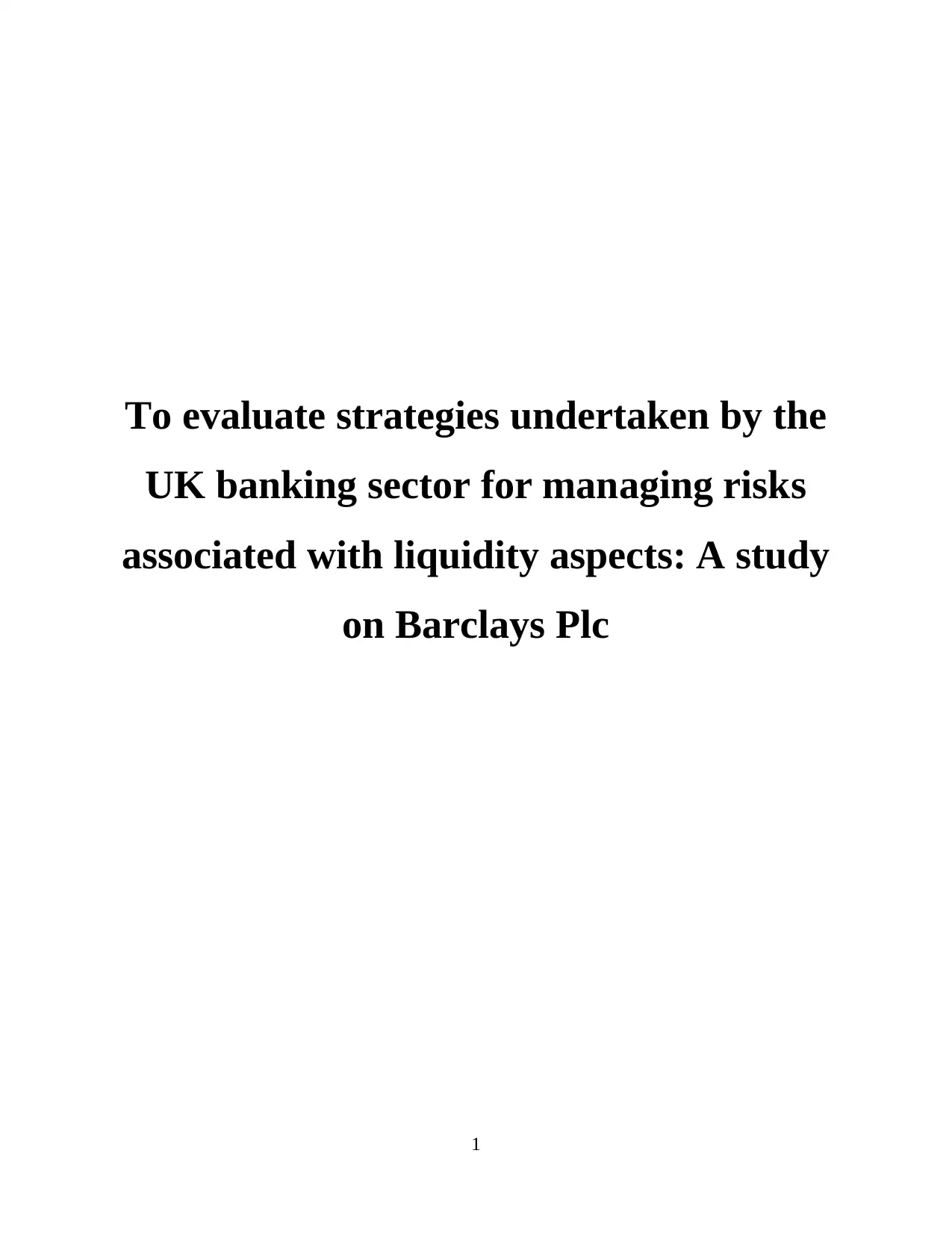
To evaluate strategies undertaken by the
UK banking sector for managing risks
associated with liquidity aspects: A study
on Barclays Plc
1
UK banking sector for managing risks
associated with liquidity aspects: A study
on Barclays Plc
1
Paraphrase This Document
Need a fresh take? Get an instant paraphrase of this document with our AI Paraphraser
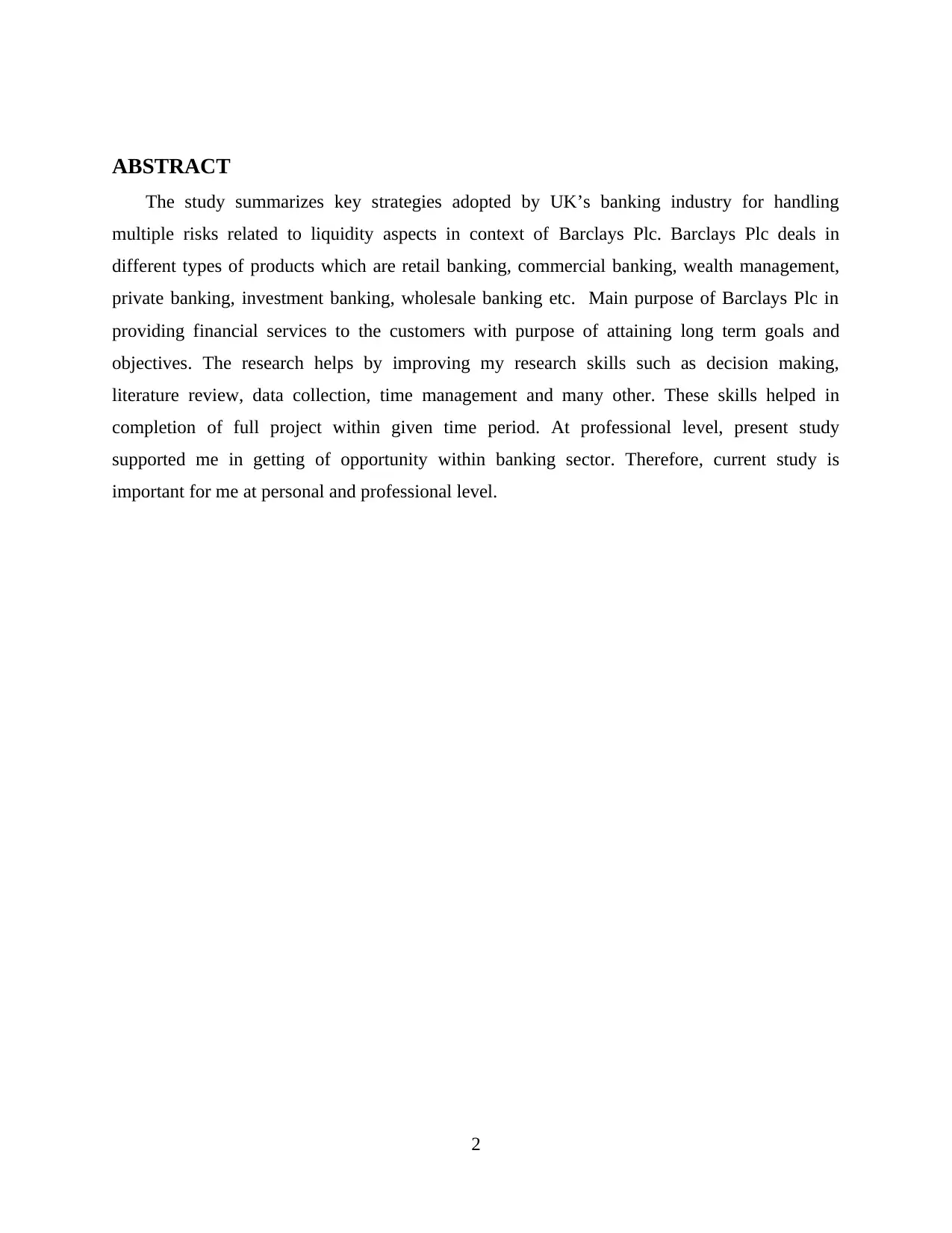
ABSTRACT
The study summarizes key strategies adopted by UK’s banking industry for handling
multiple risks related to liquidity aspects in context of Barclays Plc. Barclays Plc deals in
different types of products which are retail banking, commercial banking, wealth management,
private banking, investment banking, wholesale banking etc. Main purpose of Barclays Plc in
providing financial services to the customers with purpose of attaining long term goals and
objectives. The research helps by improving my research skills such as decision making,
literature review, data collection, time management and many other. These skills helped in
completion of full project within given time period. At professional level, present study
supported me in getting of opportunity within banking sector. Therefore, current study is
important for me at personal and professional level.
2
The study summarizes key strategies adopted by UK’s banking industry for handling
multiple risks related to liquidity aspects in context of Barclays Plc. Barclays Plc deals in
different types of products which are retail banking, commercial banking, wealth management,
private banking, investment banking, wholesale banking etc. Main purpose of Barclays Plc in
providing financial services to the customers with purpose of attaining long term goals and
objectives. The research helps by improving my research skills such as decision making,
literature review, data collection, time management and many other. These skills helped in
completion of full project within given time period. At professional level, present study
supported me in getting of opportunity within banking sector. Therefore, current study is
important for me at personal and professional level.
2
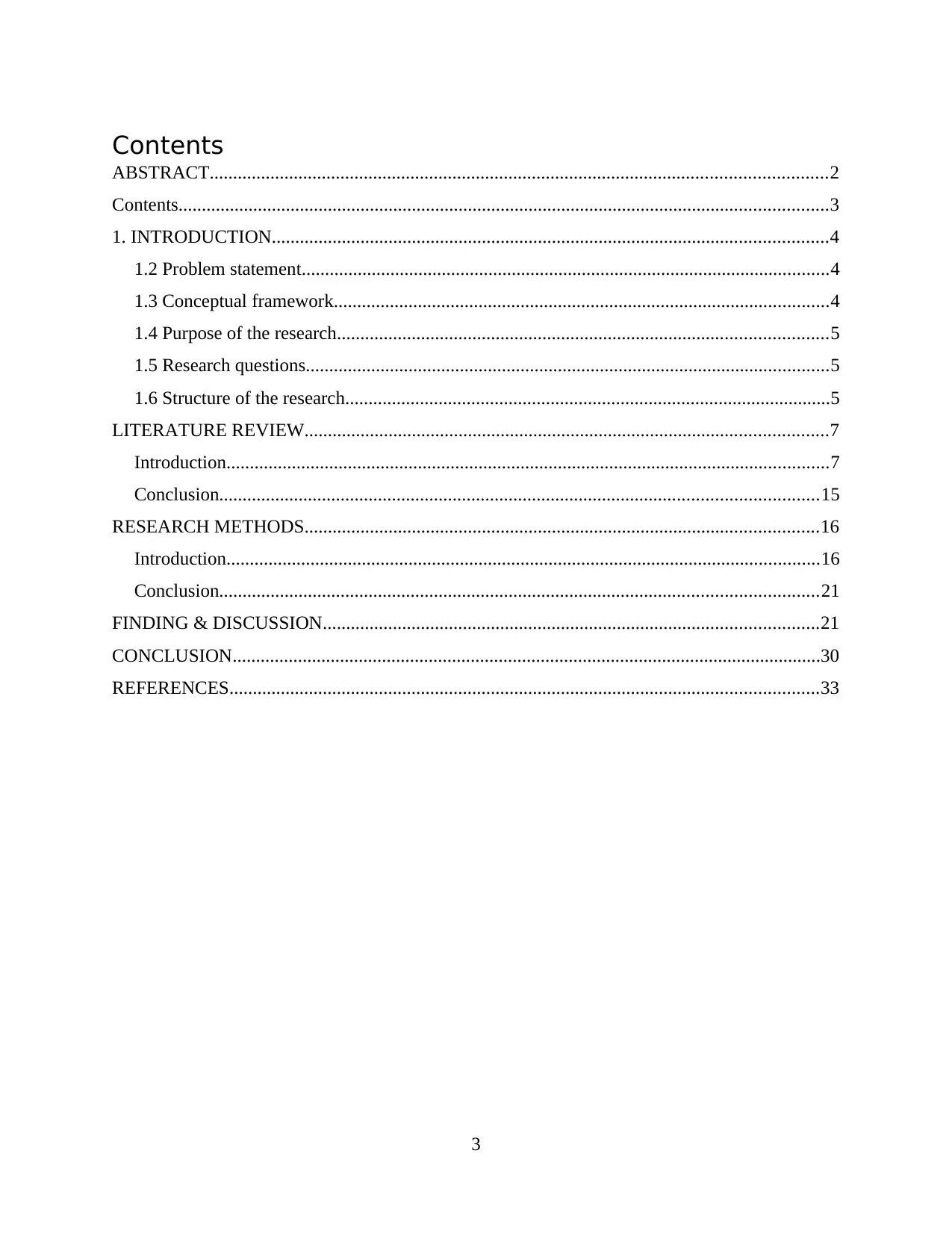
Contents
ABSTRACT....................................................................................................................................2
Contents...........................................................................................................................................3
1. INTRODUCTION.......................................................................................................................4
1.2 Problem statement.................................................................................................................4
1.3 Conceptual framework..........................................................................................................4
1.4 Purpose of the research.........................................................................................................5
1.5 Research questions................................................................................................................5
1.6 Structure of the research........................................................................................................5
LITERATURE REVIEW................................................................................................................7
Introduction.................................................................................................................................7
Conclusion................................................................................................................................15
RESEARCH METHODS..............................................................................................................16
Introduction...............................................................................................................................16
Conclusion................................................................................................................................21
FINDING & DISCUSSION..........................................................................................................21
CONCLUSION..............................................................................................................................30
REFERENCES..............................................................................................................................33
3
ABSTRACT....................................................................................................................................2
Contents...........................................................................................................................................3
1. INTRODUCTION.......................................................................................................................4
1.2 Problem statement.................................................................................................................4
1.3 Conceptual framework..........................................................................................................4
1.4 Purpose of the research.........................................................................................................5
1.5 Research questions................................................................................................................5
1.6 Structure of the research........................................................................................................5
LITERATURE REVIEW................................................................................................................7
Introduction.................................................................................................................................7
Conclusion................................................................................................................................15
RESEARCH METHODS..............................................................................................................16
Introduction...............................................................................................................................16
Conclusion................................................................................................................................21
FINDING & DISCUSSION..........................................................................................................21
CONCLUSION..............................................................................................................................30
REFERENCES..............................................................................................................................33
3
⊘ This is a preview!⊘
Do you want full access?
Subscribe today to unlock all pages.

Trusted by 1+ million students worldwide
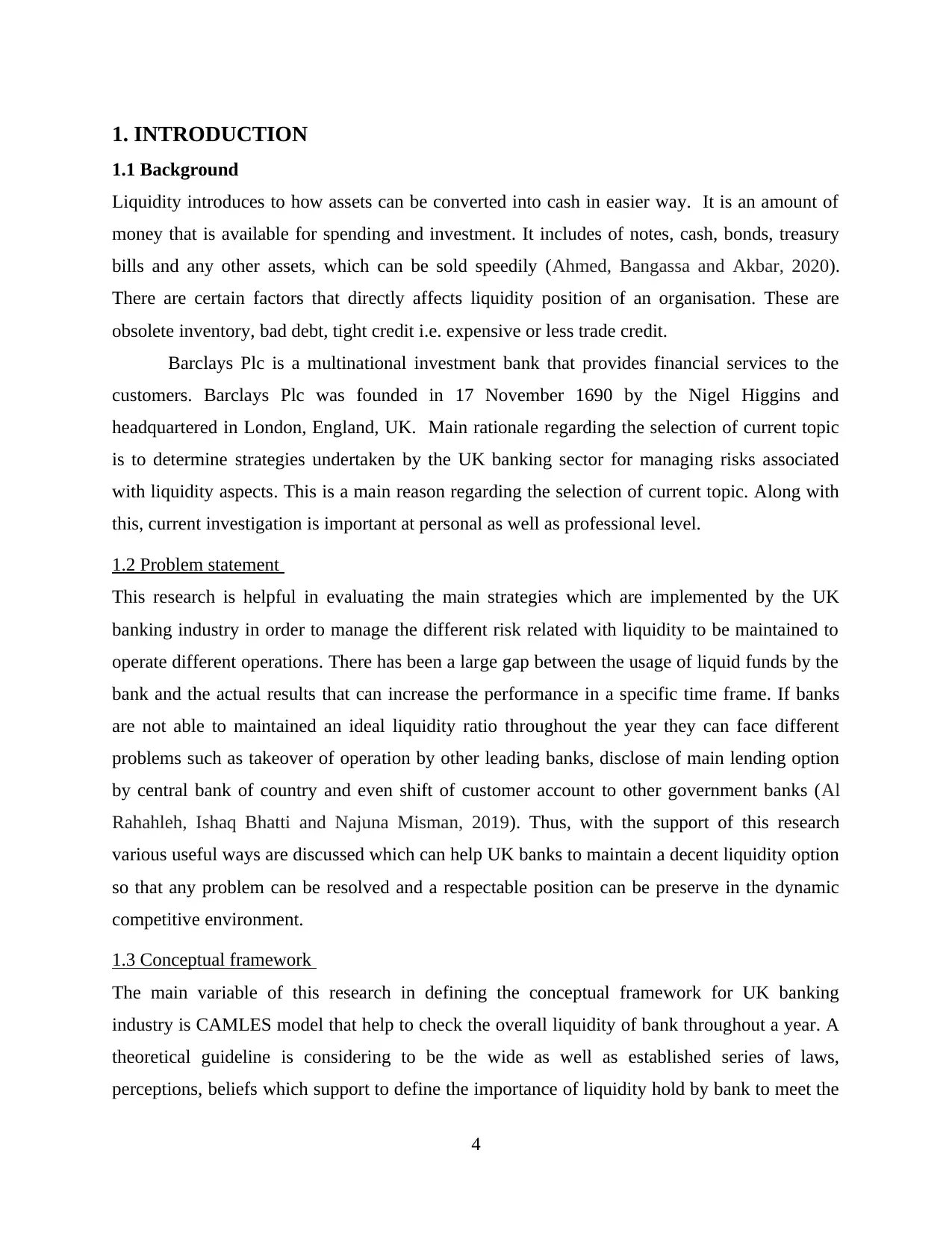
1. INTRODUCTION
1.1 Background
Liquidity introduces to how assets can be converted into cash in easier way. It is an amount of
money that is available for spending and investment. It includes of notes, cash, bonds, treasury
bills and any other assets, which can be sold speedily (Ahmed, Bangassa and Akbar, 2020).
There are certain factors that directly affects liquidity position of an organisation. These are
obsolete inventory, bad debt, tight credit i.e. expensive or less trade credit.
Barclays Plc is a multinational investment bank that provides financial services to the
customers. Barclays Plc was founded in 17 November 1690 by the Nigel Higgins and
headquartered in London, England, UK. Main rationale regarding the selection of current topic
is to determine strategies undertaken by the UK banking sector for managing risks associated
with liquidity aspects. This is a main reason regarding the selection of current topic. Along with
this, current investigation is important at personal as well as professional level.
1.2 Problem statement
This research is helpful in evaluating the main strategies which are implemented by the UK
banking industry in order to manage the different risk related with liquidity to be maintained to
operate different operations. There has been a large gap between the usage of liquid funds by the
bank and the actual results that can increase the performance in a specific time frame. If banks
are not able to maintained an ideal liquidity ratio throughout the year they can face different
problems such as takeover of operation by other leading banks, disclose of main lending option
by central bank of country and even shift of customer account to other government banks (Al
Rahahleh, Ishaq Bhatti and Najuna Misman, 2019). Thus, with the support of this research
various useful ways are discussed which can help UK banks to maintain a decent liquidity option
so that any problem can be resolved and a respectable position can be preserve in the dynamic
competitive environment.
1.3 Conceptual framework
The main variable of this research in defining the conceptual framework for UK banking
industry is CAMLES model that help to check the overall liquidity of bank throughout a year. A
theoretical guideline is considering to be the wide as well as established series of laws,
perceptions, beliefs which support to define the importance of liquidity hold by bank to meet the
4
1.1 Background
Liquidity introduces to how assets can be converted into cash in easier way. It is an amount of
money that is available for spending and investment. It includes of notes, cash, bonds, treasury
bills and any other assets, which can be sold speedily (Ahmed, Bangassa and Akbar, 2020).
There are certain factors that directly affects liquidity position of an organisation. These are
obsolete inventory, bad debt, tight credit i.e. expensive or less trade credit.
Barclays Plc is a multinational investment bank that provides financial services to the
customers. Barclays Plc was founded in 17 November 1690 by the Nigel Higgins and
headquartered in London, England, UK. Main rationale regarding the selection of current topic
is to determine strategies undertaken by the UK banking sector for managing risks associated
with liquidity aspects. This is a main reason regarding the selection of current topic. Along with
this, current investigation is important at personal as well as professional level.
1.2 Problem statement
This research is helpful in evaluating the main strategies which are implemented by the UK
banking industry in order to manage the different risk related with liquidity to be maintained to
operate different operations. There has been a large gap between the usage of liquid funds by the
bank and the actual results that can increase the performance in a specific time frame. If banks
are not able to maintained an ideal liquidity ratio throughout the year they can face different
problems such as takeover of operation by other leading banks, disclose of main lending option
by central bank of country and even shift of customer account to other government banks (Al
Rahahleh, Ishaq Bhatti and Najuna Misman, 2019). Thus, with the support of this research
various useful ways are discussed which can help UK banks to maintain a decent liquidity option
so that any problem can be resolved and a respectable position can be preserve in the dynamic
competitive environment.
1.3 Conceptual framework
The main variable of this research in defining the conceptual framework for UK banking
industry is CAMLES model that help to check the overall liquidity of bank throughout a year. A
theoretical guideline is considering to be the wide as well as established series of laws,
perceptions, beliefs which support to define the importance of liquidity hold by bank to meet the
4
Paraphrase This Document
Need a fresh take? Get an instant paraphrase of this document with our AI Paraphraser
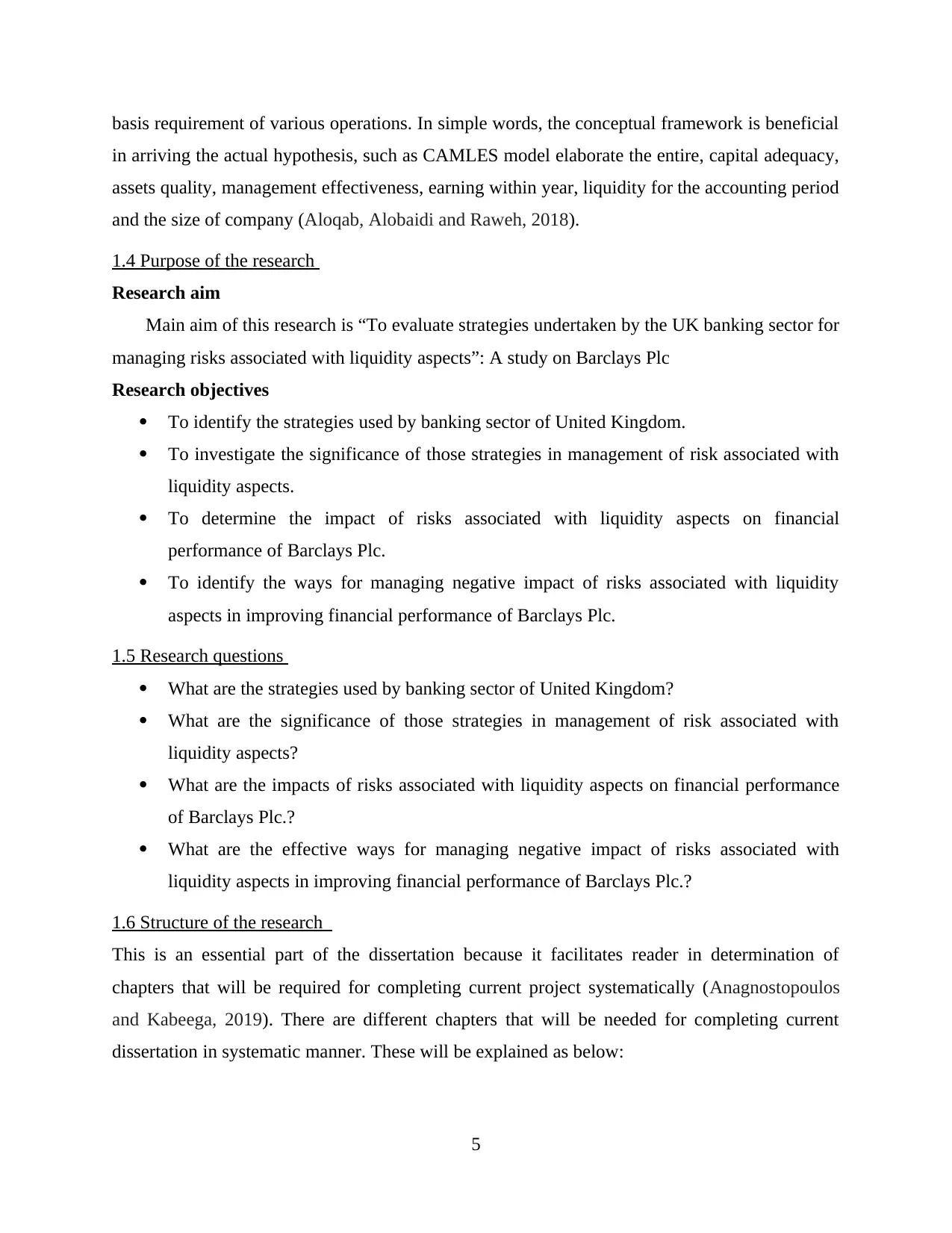
basis requirement of various operations. In simple words, the conceptual framework is beneficial
in arriving the actual hypothesis, such as CAMLES model elaborate the entire, capital adequacy,
assets quality, management effectiveness, earning within year, liquidity for the accounting period
and the size of company (Aloqab, Alobaidi and Raweh, 2018).
1.4 Purpose of the research
Research aim
Main aim of this research is “To evaluate strategies undertaken by the UK banking sector for
managing risks associated with liquidity aspects”: A study on Barclays Plc
Research objectives
To identify the strategies used by banking sector of United Kingdom.
To investigate the significance of those strategies in management of risk associated with
liquidity aspects.
To determine the impact of risks associated with liquidity aspects on financial
performance of Barclays Plc.
To identify the ways for managing negative impact of risks associated with liquidity
aspects in improving financial performance of Barclays Plc.
1.5 Research questions
What are the strategies used by banking sector of United Kingdom?
What are the significance of those strategies in management of risk associated with
liquidity aspects?
What are the impacts of risks associated with liquidity aspects on financial performance
of Barclays Plc.?
What are the effective ways for managing negative impact of risks associated with
liquidity aspects in improving financial performance of Barclays Plc.?
1.6 Structure of the research
This is an essential part of the dissertation because it facilitates reader in determination of
chapters that will be required for completing current project systematically (Anagnostopoulos
and Kabeega, 2019). There are different chapters that will be needed for completing current
dissertation in systematic manner. These will be explained as below:
5
in arriving the actual hypothesis, such as CAMLES model elaborate the entire, capital adequacy,
assets quality, management effectiveness, earning within year, liquidity for the accounting period
and the size of company (Aloqab, Alobaidi and Raweh, 2018).
1.4 Purpose of the research
Research aim
Main aim of this research is “To evaluate strategies undertaken by the UK banking sector for
managing risks associated with liquidity aspects”: A study on Barclays Plc
Research objectives
To identify the strategies used by banking sector of United Kingdom.
To investigate the significance of those strategies in management of risk associated with
liquidity aspects.
To determine the impact of risks associated with liquidity aspects on financial
performance of Barclays Plc.
To identify the ways for managing negative impact of risks associated with liquidity
aspects in improving financial performance of Barclays Plc.
1.5 Research questions
What are the strategies used by banking sector of United Kingdom?
What are the significance of those strategies in management of risk associated with
liquidity aspects?
What are the impacts of risks associated with liquidity aspects on financial performance
of Barclays Plc.?
What are the effective ways for managing negative impact of risks associated with
liquidity aspects in improving financial performance of Barclays Plc.?
1.6 Structure of the research
This is an essential part of the dissertation because it facilitates reader in determination of
chapters that will be required for completing current project systematically (Anagnostopoulos
and Kabeega, 2019). There are different chapters that will be needed for completing current
dissertation in systematic manner. These will be explained as below:
5
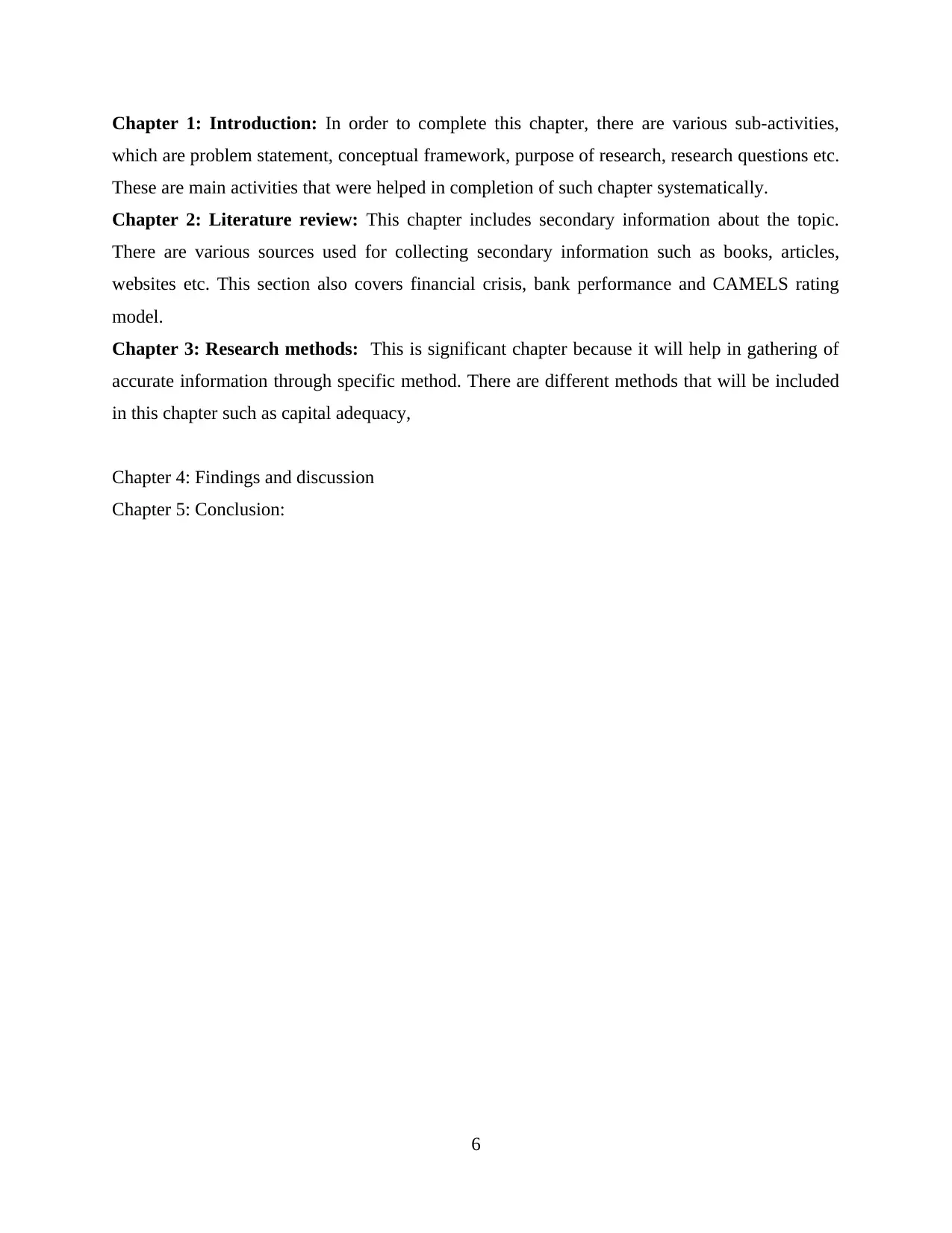
Chapter 1: Introduction: In order to complete this chapter, there are various sub-activities,
which are problem statement, conceptual framework, purpose of research, research questions etc.
These are main activities that were helped in completion of such chapter systematically.
Chapter 2: Literature review: This chapter includes secondary information about the topic.
There are various sources used for collecting secondary information such as books, articles,
websites etc. This section also covers financial crisis, bank performance and CAMELS rating
model.
Chapter 3: Research methods: This is significant chapter because it will help in gathering of
accurate information through specific method. There are different methods that will be included
in this chapter such as capital adequacy,
Chapter 4: Findings and discussion
Chapter 5: Conclusion:
6
which are problem statement, conceptual framework, purpose of research, research questions etc.
These are main activities that were helped in completion of such chapter systematically.
Chapter 2: Literature review: This chapter includes secondary information about the topic.
There are various sources used for collecting secondary information such as books, articles,
websites etc. This section also covers financial crisis, bank performance and CAMELS rating
model.
Chapter 3: Research methods: This is significant chapter because it will help in gathering of
accurate information through specific method. There are different methods that will be included
in this chapter such as capital adequacy,
Chapter 4: Findings and discussion
Chapter 5: Conclusion:
6
⊘ This is a preview!⊘
Do you want full access?
Subscribe today to unlock all pages.

Trusted by 1+ million students worldwide
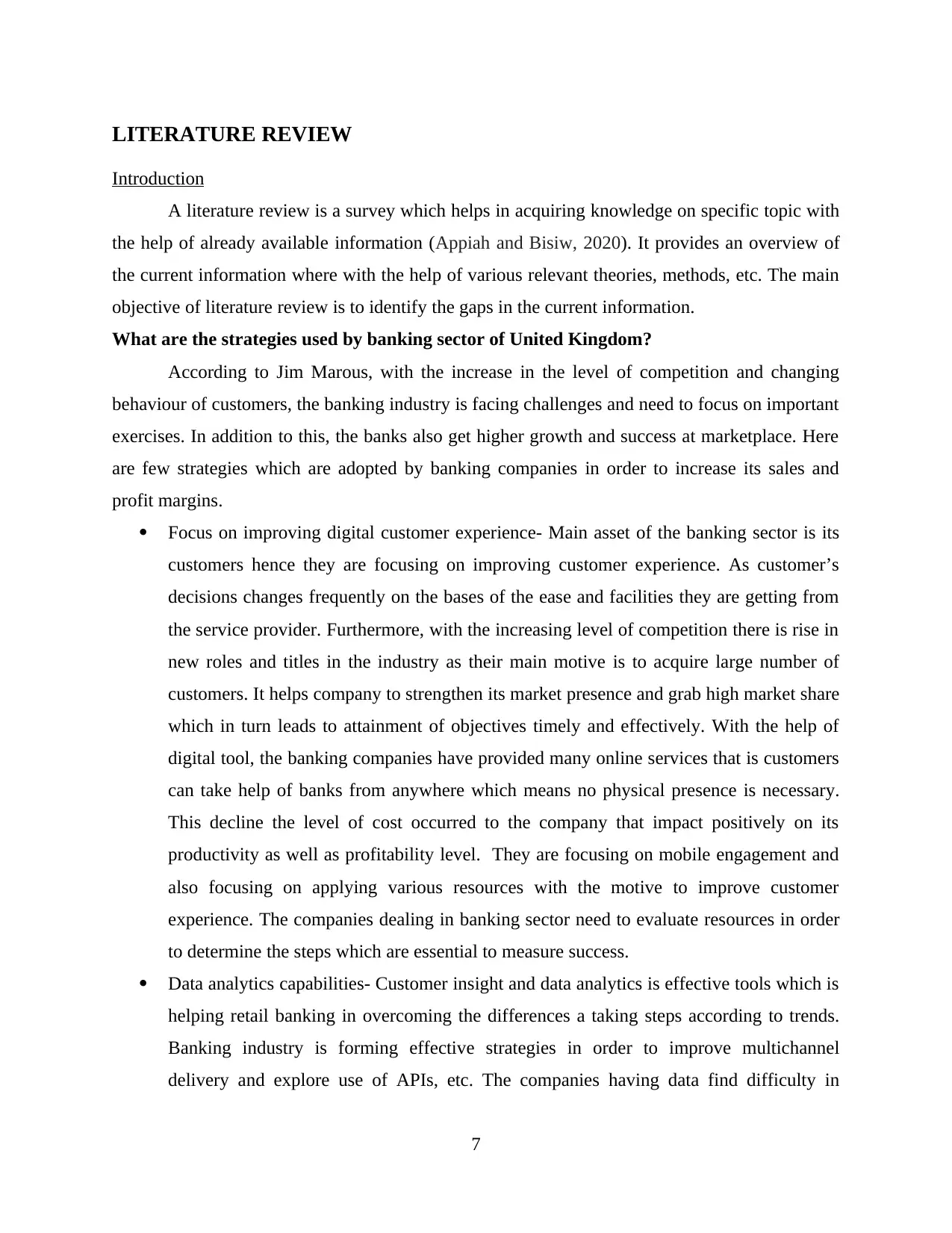
LITERATURE REVIEW
Introduction
A literature review is a survey which helps in acquiring knowledge on specific topic with
the help of already available information (Appiah and Bisiw, 2020). It provides an overview of
the current information where with the help of various relevant theories, methods, etc. The main
objective of literature review is to identify the gaps in the current information.
What are the strategies used by banking sector of United Kingdom?
According to Jim Marous, with the increase in the level of competition and changing
behaviour of customers, the banking industry is facing challenges and need to focus on important
exercises. In addition to this, the banks also get higher growth and success at marketplace. Here
are few strategies which are adopted by banking companies in order to increase its sales and
profit margins.
Focus on improving digital customer experience- Main asset of the banking sector is its
customers hence they are focusing on improving customer experience. As customer’s
decisions changes frequently on the bases of the ease and facilities they are getting from
the service provider. Furthermore, with the increasing level of competition there is rise in
new roles and titles in the industry as their main motive is to acquire large number of
customers. It helps company to strengthen its market presence and grab high market share
which in turn leads to attainment of objectives timely and effectively. With the help of
digital tool, the banking companies have provided many online services that is customers
can take help of banks from anywhere which means no physical presence is necessary.
This decline the level of cost occurred to the company that impact positively on its
productivity as well as profitability level. They are focusing on mobile engagement and
also focusing on applying various resources with the motive to improve customer
experience. The companies dealing in banking sector need to evaluate resources in order
to determine the steps which are essential to measure success.
Data analytics capabilities- Customer insight and data analytics is effective tools which is
helping retail banking in overcoming the differences a taking steps according to trends.
Banking industry is forming effective strategies in order to improve multichannel
delivery and explore use of APIs, etc. The companies having data find difficulty in
7
Introduction
A literature review is a survey which helps in acquiring knowledge on specific topic with
the help of already available information (Appiah and Bisiw, 2020). It provides an overview of
the current information where with the help of various relevant theories, methods, etc. The main
objective of literature review is to identify the gaps in the current information.
What are the strategies used by banking sector of United Kingdom?
According to Jim Marous, with the increase in the level of competition and changing
behaviour of customers, the banking industry is facing challenges and need to focus on important
exercises. In addition to this, the banks also get higher growth and success at marketplace. Here
are few strategies which are adopted by banking companies in order to increase its sales and
profit margins.
Focus on improving digital customer experience- Main asset of the banking sector is its
customers hence they are focusing on improving customer experience. As customer’s
decisions changes frequently on the bases of the ease and facilities they are getting from
the service provider. Furthermore, with the increasing level of competition there is rise in
new roles and titles in the industry as their main motive is to acquire large number of
customers. It helps company to strengthen its market presence and grab high market share
which in turn leads to attainment of objectives timely and effectively. With the help of
digital tool, the banking companies have provided many online services that is customers
can take help of banks from anywhere which means no physical presence is necessary.
This decline the level of cost occurred to the company that impact positively on its
productivity as well as profitability level. They are focusing on mobile engagement and
also focusing on applying various resources with the motive to improve customer
experience. The companies dealing in banking sector need to evaluate resources in order
to determine the steps which are essential to measure success.
Data analytics capabilities- Customer insight and data analytics is effective tools which is
helping retail banking in overcoming the differences a taking steps according to trends.
Banking industry is forming effective strategies in order to improve multichannel
delivery and explore use of APIs, etc. The companies having data find difficulty in
7
Paraphrase This Document
Need a fresh take? Get an instant paraphrase of this document with our AI Paraphraser
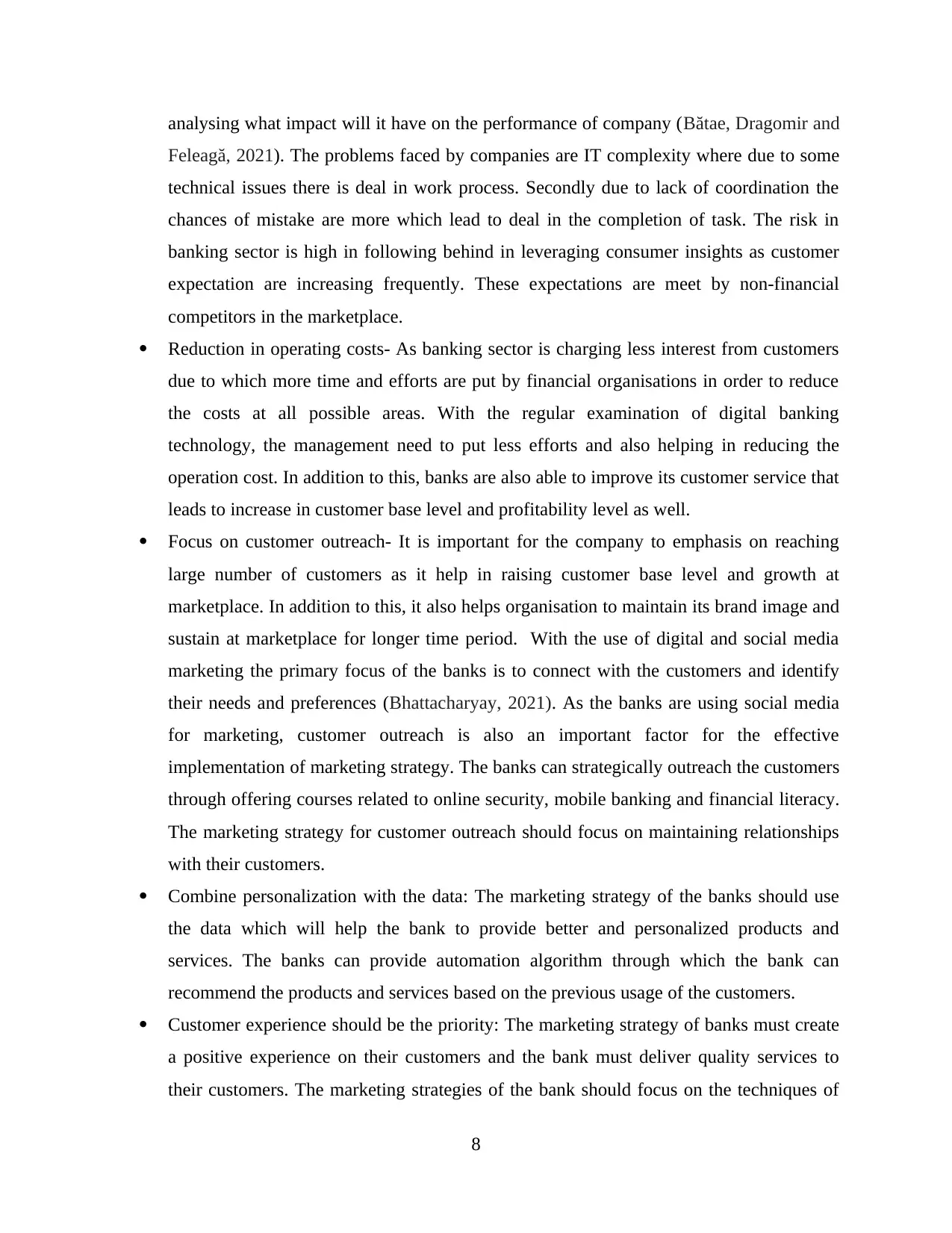
analysing what impact will it have on the performance of company (Bătae, Dragomir and
Feleagă, 2021). The problems faced by companies are IT complexity where due to some
technical issues there is deal in work process. Secondly due to lack of coordination the
chances of mistake are more which lead to deal in the completion of task. The risk in
banking sector is high in following behind in leveraging consumer insights as customer
expectation are increasing frequently. These expectations are meet by non-financial
competitors in the marketplace.
Reduction in operating costs- As banking sector is charging less interest from customers
due to which more time and efforts are put by financial organisations in order to reduce
the costs at all possible areas. With the regular examination of digital banking
technology, the management need to put less efforts and also helping in reducing the
operation cost. In addition to this, banks are also able to improve its customer service that
leads to increase in customer base level and profitability level as well.
Focus on customer outreach- It is important for the company to emphasis on reaching
large number of customers as it help in raising customer base level and growth at
marketplace. In addition to this, it also helps organisation to maintain its brand image and
sustain at marketplace for longer time period. With the use of digital and social media
marketing the primary focus of the banks is to connect with the customers and identify
their needs and preferences (Bhattacharyay, 2021). As the banks are using social media
for marketing, customer outreach is also an important factor for the effective
implementation of marketing strategy. The banks can strategically outreach the customers
through offering courses related to online security, mobile banking and financial literacy.
The marketing strategy for customer outreach should focus on maintaining relationships
with their customers.
Combine personalization with the data: The marketing strategy of the banks should use
the data which will help the bank to provide better and personalized products and
services. The banks can provide automation algorithm through which the bank can
recommend the products and services based on the previous usage of the customers.
Customer experience should be the priority: The marketing strategy of banks must create
a positive experience on their customers and the bank must deliver quality services to
their customers. The marketing strategies of the bank should focus on the techniques of
8
Feleagă, 2021). The problems faced by companies are IT complexity where due to some
technical issues there is deal in work process. Secondly due to lack of coordination the
chances of mistake are more which lead to deal in the completion of task. The risk in
banking sector is high in following behind in leveraging consumer insights as customer
expectation are increasing frequently. These expectations are meet by non-financial
competitors in the marketplace.
Reduction in operating costs- As banking sector is charging less interest from customers
due to which more time and efforts are put by financial organisations in order to reduce
the costs at all possible areas. With the regular examination of digital banking
technology, the management need to put less efforts and also helping in reducing the
operation cost. In addition to this, banks are also able to improve its customer service that
leads to increase in customer base level and profitability level as well.
Focus on customer outreach- It is important for the company to emphasis on reaching
large number of customers as it help in raising customer base level and growth at
marketplace. In addition to this, it also helps organisation to maintain its brand image and
sustain at marketplace for longer time period. With the use of digital and social media
marketing the primary focus of the banks is to connect with the customers and identify
their needs and preferences (Bhattacharyay, 2021). As the banks are using social media
for marketing, customer outreach is also an important factor for the effective
implementation of marketing strategy. The banks can strategically outreach the customers
through offering courses related to online security, mobile banking and financial literacy.
The marketing strategy for customer outreach should focus on maintaining relationships
with their customers.
Combine personalization with the data: The marketing strategy of the banks should use
the data which will help the bank to provide better and personalized products and
services. The banks can provide automation algorithm through which the bank can
recommend the products and services based on the previous usage of the customers.
Customer experience should be the priority: The marketing strategy of banks must create
a positive experience on their customers and the bank must deliver quality services to
their customers. The marketing strategies of the bank should focus on the techniques of
8
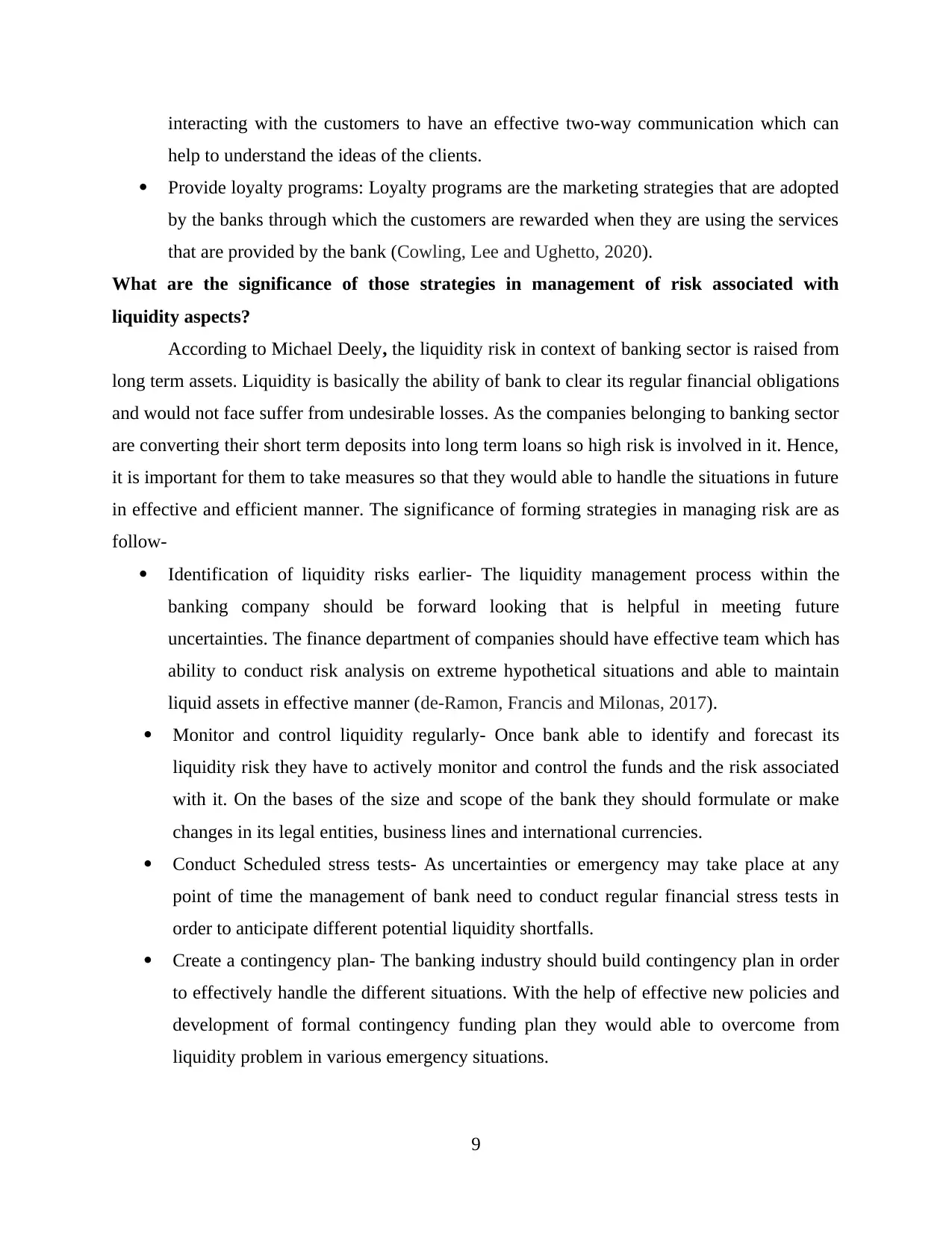
interacting with the customers to have an effective two-way communication which can
help to understand the ideas of the clients.
Provide loyalty programs: Loyalty programs are the marketing strategies that are adopted
by the banks through which the customers are rewarded when they are using the services
that are provided by the bank (Cowling, Lee and Ughetto, 2020).
What are the significance of those strategies in management of risk associated with
liquidity aspects?
According to Michael Deely, the liquidity risk in context of banking sector is raised from
long term assets. Liquidity is basically the ability of bank to clear its regular financial obligations
and would not face suffer from undesirable losses. As the companies belonging to banking sector
are converting their short term deposits into long term loans so high risk is involved in it. Hence,
it is important for them to take measures so that they would able to handle the situations in future
in effective and efficient manner. The significance of forming strategies in managing risk are as
follow-
Identification of liquidity risks earlier- The liquidity management process within the
banking company should be forward looking that is helpful in meeting future
uncertainties. The finance department of companies should have effective team which has
ability to conduct risk analysis on extreme hypothetical situations and able to maintain
liquid assets in effective manner (de-Ramon, Francis and Milonas, 2017).
Monitor and control liquidity regularly- Once bank able to identify and forecast its
liquidity risk they have to actively monitor and control the funds and the risk associated
with it. On the bases of the size and scope of the bank they should formulate or make
changes in its legal entities, business lines and international currencies.
Conduct Scheduled stress tests- As uncertainties or emergency may take place at any
point of time the management of bank need to conduct regular financial stress tests in
order to anticipate different potential liquidity shortfalls.
Create a contingency plan- The banking industry should build contingency plan in order
to effectively handle the different situations. With the help of effective new policies and
development of formal contingency funding plan they would able to overcome from
liquidity problem in various emergency situations.
9
help to understand the ideas of the clients.
Provide loyalty programs: Loyalty programs are the marketing strategies that are adopted
by the banks through which the customers are rewarded when they are using the services
that are provided by the bank (Cowling, Lee and Ughetto, 2020).
What are the significance of those strategies in management of risk associated with
liquidity aspects?
According to Michael Deely, the liquidity risk in context of banking sector is raised from
long term assets. Liquidity is basically the ability of bank to clear its regular financial obligations
and would not face suffer from undesirable losses. As the companies belonging to banking sector
are converting their short term deposits into long term loans so high risk is involved in it. Hence,
it is important for them to take measures so that they would able to handle the situations in future
in effective and efficient manner. The significance of forming strategies in managing risk are as
follow-
Identification of liquidity risks earlier- The liquidity management process within the
banking company should be forward looking that is helpful in meeting future
uncertainties. The finance department of companies should have effective team which has
ability to conduct risk analysis on extreme hypothetical situations and able to maintain
liquid assets in effective manner (de-Ramon, Francis and Milonas, 2017).
Monitor and control liquidity regularly- Once bank able to identify and forecast its
liquidity risk they have to actively monitor and control the funds and the risk associated
with it. On the bases of the size and scope of the bank they should formulate or make
changes in its legal entities, business lines and international currencies.
Conduct Scheduled stress tests- As uncertainties or emergency may take place at any
point of time the management of bank need to conduct regular financial stress tests in
order to anticipate different potential liquidity shortfalls.
Create a contingency plan- The banking industry should build contingency plan in order
to effectively handle the different situations. With the help of effective new policies and
development of formal contingency funding plan they would able to overcome from
liquidity problem in various emergency situations.
9
⊘ This is a preview!⊘
Do you want full access?
Subscribe today to unlock all pages.

Trusted by 1+ million students worldwide
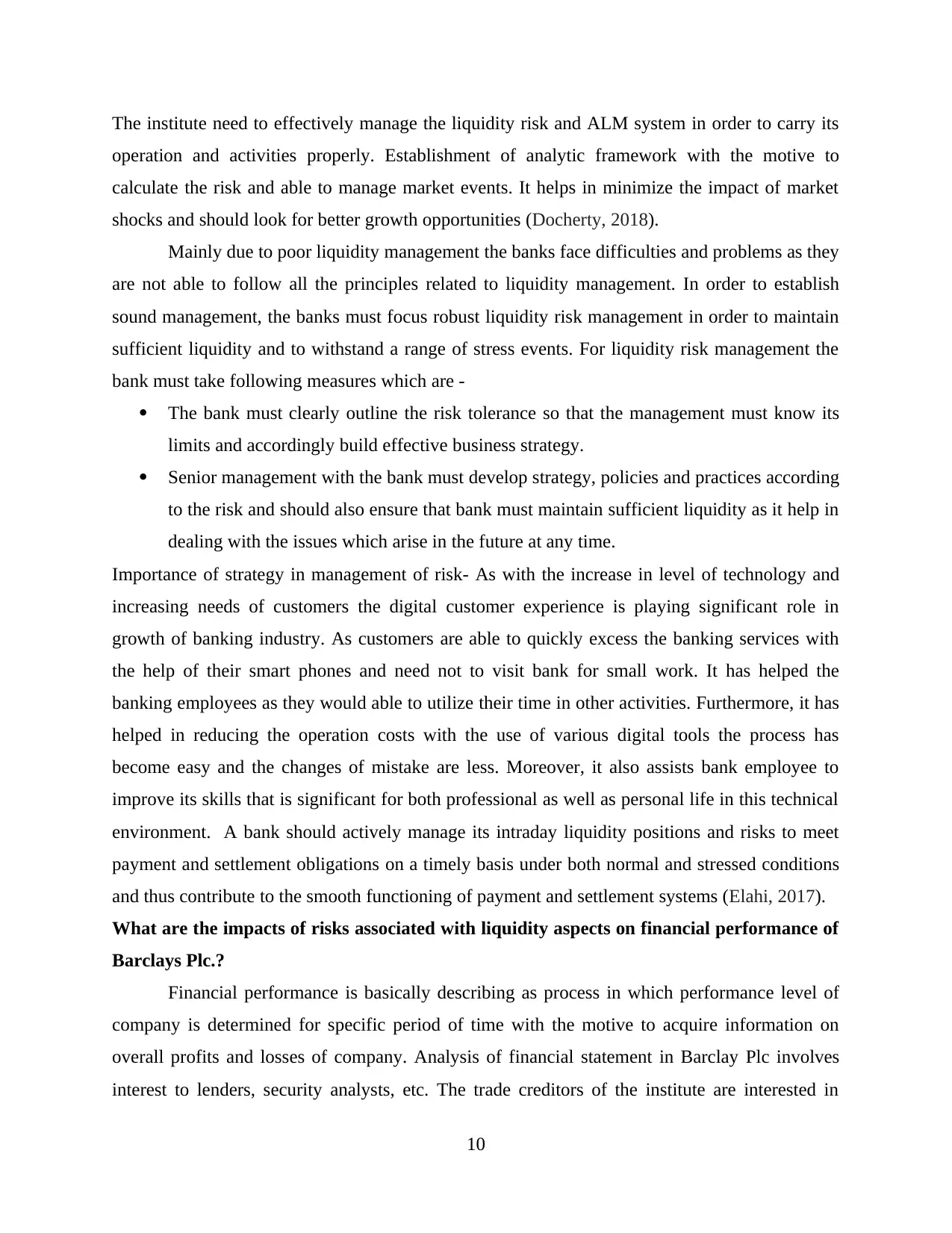
The institute need to effectively manage the liquidity risk and ALM system in order to carry its
operation and activities properly. Establishment of analytic framework with the motive to
calculate the risk and able to manage market events. It helps in minimize the impact of market
shocks and should look for better growth opportunities (Docherty, 2018).
Mainly due to poor liquidity management the banks face difficulties and problems as they
are not able to follow all the principles related to liquidity management. In order to establish
sound management, the banks must focus robust liquidity risk management in order to maintain
sufficient liquidity and to withstand a range of stress events. For liquidity risk management the
bank must take following measures which are -
The bank must clearly outline the risk tolerance so that the management must know its
limits and accordingly build effective business strategy.
Senior management with the bank must develop strategy, policies and practices according
to the risk and should also ensure that bank must maintain sufficient liquidity as it help in
dealing with the issues which arise in the future at any time.
Importance of strategy in management of risk- As with the increase in level of technology and
increasing needs of customers the digital customer experience is playing significant role in
growth of banking industry. As customers are able to quickly excess the banking services with
the help of their smart phones and need not to visit bank for small work. It has helped the
banking employees as they would able to utilize their time in other activities. Furthermore, it has
helped in reducing the operation costs with the use of various digital tools the process has
become easy and the changes of mistake are less. Moreover, it also assists bank employee to
improve its skills that is significant for both professional as well as personal life in this technical
environment. A bank should actively manage its intraday liquidity positions and risks to meet
payment and settlement obligations on a timely basis under both normal and stressed conditions
and thus contribute to the smooth functioning of payment and settlement systems (Elahi, 2017).
What are the impacts of risks associated with liquidity aspects on financial performance of
Barclays Plc.?
Financial performance is basically describing as process in which performance level of
company is determined for specific period of time with the motive to acquire information on
overall profits and losses of company. Analysis of financial statement in Barclay Plc involves
interest to lenders, security analysts, etc. The trade creditors of the institute are interested in
10
operation and activities properly. Establishment of analytic framework with the motive to
calculate the risk and able to manage market events. It helps in minimize the impact of market
shocks and should look for better growth opportunities (Docherty, 2018).
Mainly due to poor liquidity management the banks face difficulties and problems as they
are not able to follow all the principles related to liquidity management. In order to establish
sound management, the banks must focus robust liquidity risk management in order to maintain
sufficient liquidity and to withstand a range of stress events. For liquidity risk management the
bank must take following measures which are -
The bank must clearly outline the risk tolerance so that the management must know its
limits and accordingly build effective business strategy.
Senior management with the bank must develop strategy, policies and practices according
to the risk and should also ensure that bank must maintain sufficient liquidity as it help in
dealing with the issues which arise in the future at any time.
Importance of strategy in management of risk- As with the increase in level of technology and
increasing needs of customers the digital customer experience is playing significant role in
growth of banking industry. As customers are able to quickly excess the banking services with
the help of their smart phones and need not to visit bank for small work. It has helped the
banking employees as they would able to utilize their time in other activities. Furthermore, it has
helped in reducing the operation costs with the use of various digital tools the process has
become easy and the changes of mistake are less. Moreover, it also assists bank employee to
improve its skills that is significant for both professional as well as personal life in this technical
environment. A bank should actively manage its intraday liquidity positions and risks to meet
payment and settlement obligations on a timely basis under both normal and stressed conditions
and thus contribute to the smooth functioning of payment and settlement systems (Elahi, 2017).
What are the impacts of risks associated with liquidity aspects on financial performance of
Barclays Plc.?
Financial performance is basically describing as process in which performance level of
company is determined for specific period of time with the motive to acquire information on
overall profits and losses of company. Analysis of financial statement in Barclay Plc involves
interest to lenders, security analysts, etc. The trade creditors of the institute are interested in
10
Paraphrase This Document
Need a fresh take? Get an instant paraphrase of this document with our AI Paraphraser
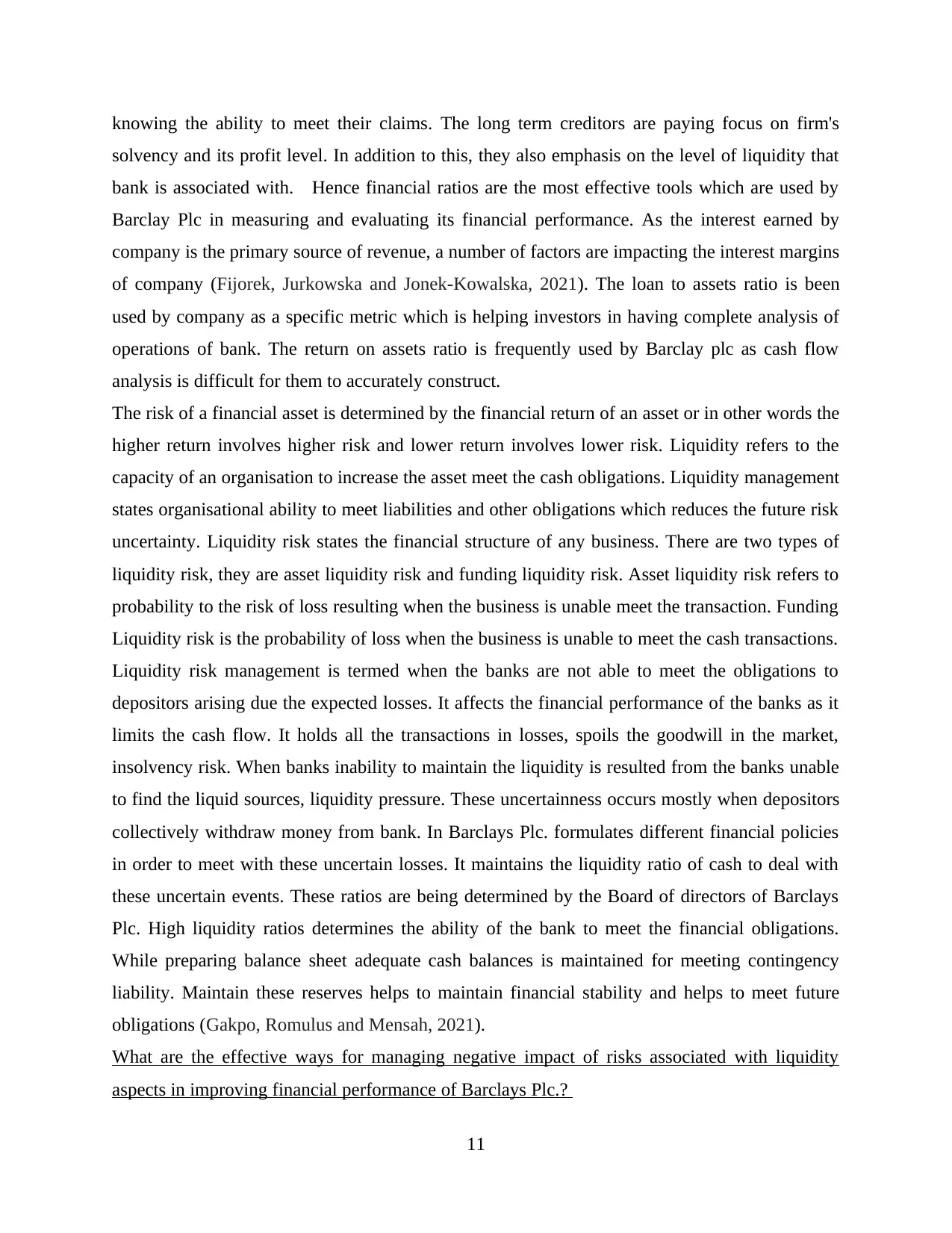
knowing the ability to meet their claims. The long term creditors are paying focus on firm's
solvency and its profit level. In addition to this, they also emphasis on the level of liquidity that
bank is associated with. Hence financial ratios are the most effective tools which are used by
Barclay Plc in measuring and evaluating its financial performance. As the interest earned by
company is the primary source of revenue, a number of factors are impacting the interest margins
of company (Fijorek, Jurkowska and Jonek-Kowalska, 2021). The loan to assets ratio is been
used by company as a specific metric which is helping investors in having complete analysis of
operations of bank. The return on assets ratio is frequently used by Barclay plc as cash flow
analysis is difficult for them to accurately construct.
The risk of a financial asset is determined by the financial return of an asset or in other words the
higher return involves higher risk and lower return involves lower risk. Liquidity refers to the
capacity of an organisation to increase the asset meet the cash obligations. Liquidity management
states organisational ability to meet liabilities and other obligations which reduces the future risk
uncertainty. Liquidity risk states the financial structure of any business. There are two types of
liquidity risk, they are asset liquidity risk and funding liquidity risk. Asset liquidity risk refers to
probability to the risk of loss resulting when the business is unable meet the transaction. Funding
Liquidity risk is the probability of loss when the business is unable to meet the cash transactions.
Liquidity risk management is termed when the banks are not able to meet the obligations to
depositors arising due the expected losses. It affects the financial performance of the banks as it
limits the cash flow. It holds all the transactions in losses, spoils the goodwill in the market,
insolvency risk. When banks inability to maintain the liquidity is resulted from the banks unable
to find the liquid sources, liquidity pressure. These uncertainness occurs mostly when depositors
collectively withdraw money from bank. In Barclays Plc. formulates different financial policies
in order to meet with these uncertain losses. It maintains the liquidity ratio of cash to deal with
these uncertain events. These ratios are being determined by the Board of directors of Barclays
Plc. High liquidity ratios determines the ability of the bank to meet the financial obligations.
While preparing balance sheet adequate cash balances is maintained for meeting contingency
liability. Maintain these reserves helps to maintain financial stability and helps to meet future
obligations (Gakpo, Romulus and Mensah, 2021).
What are the effective ways for managing negative impact of risks associated with liquidity
aspects in improving financial performance of Barclays Plc.?
11
solvency and its profit level. In addition to this, they also emphasis on the level of liquidity that
bank is associated with. Hence financial ratios are the most effective tools which are used by
Barclay Plc in measuring and evaluating its financial performance. As the interest earned by
company is the primary source of revenue, a number of factors are impacting the interest margins
of company (Fijorek, Jurkowska and Jonek-Kowalska, 2021). The loan to assets ratio is been
used by company as a specific metric which is helping investors in having complete analysis of
operations of bank. The return on assets ratio is frequently used by Barclay plc as cash flow
analysis is difficult for them to accurately construct.
The risk of a financial asset is determined by the financial return of an asset or in other words the
higher return involves higher risk and lower return involves lower risk. Liquidity refers to the
capacity of an organisation to increase the asset meet the cash obligations. Liquidity management
states organisational ability to meet liabilities and other obligations which reduces the future risk
uncertainty. Liquidity risk states the financial structure of any business. There are two types of
liquidity risk, they are asset liquidity risk and funding liquidity risk. Asset liquidity risk refers to
probability to the risk of loss resulting when the business is unable meet the transaction. Funding
Liquidity risk is the probability of loss when the business is unable to meet the cash transactions.
Liquidity risk management is termed when the banks are not able to meet the obligations to
depositors arising due the expected losses. It affects the financial performance of the banks as it
limits the cash flow. It holds all the transactions in losses, spoils the goodwill in the market,
insolvency risk. When banks inability to maintain the liquidity is resulted from the banks unable
to find the liquid sources, liquidity pressure. These uncertainness occurs mostly when depositors
collectively withdraw money from bank. In Barclays Plc. formulates different financial policies
in order to meet with these uncertain losses. It maintains the liquidity ratio of cash to deal with
these uncertain events. These ratios are being determined by the Board of directors of Barclays
Plc. High liquidity ratios determines the ability of the bank to meet the financial obligations.
While preparing balance sheet adequate cash balances is maintained for meeting contingency
liability. Maintain these reserves helps to maintain financial stability and helps to meet future
obligations (Gakpo, Romulus and Mensah, 2021).
What are the effective ways for managing negative impact of risks associated with liquidity
aspects in improving financial performance of Barclays Plc.?
11
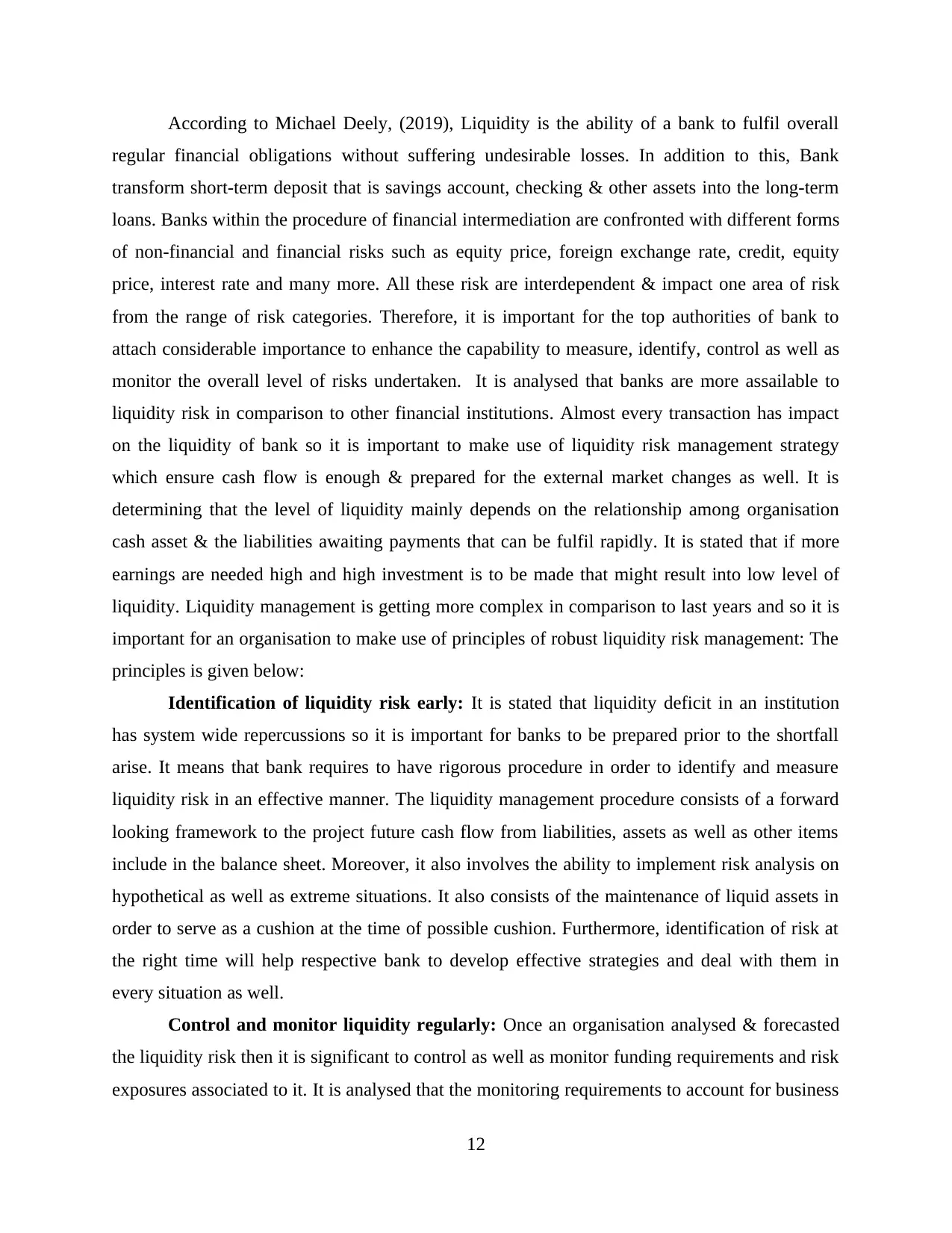
According to Michael Deely, (2019), Liquidity is the ability of a bank to fulfil overall
regular financial obligations without suffering undesirable losses. In addition to this, Bank
transform short-term deposit that is savings account, checking & other assets into the long-term
loans. Banks within the procedure of financial intermediation are confronted with different forms
of non-financial and financial risks such as equity price, foreign exchange rate, credit, equity
price, interest rate and many more. All these risk are interdependent & impact one area of risk
from the range of risk categories. Therefore, it is important for the top authorities of bank to
attach considerable importance to enhance the capability to measure, identify, control as well as
monitor the overall level of risks undertaken. It is analysed that banks are more assailable to
liquidity risk in comparison to other financial institutions. Almost every transaction has impact
on the liquidity of bank so it is important to make use of liquidity risk management strategy
which ensure cash flow is enough & prepared for the external market changes as well. It is
determining that the level of liquidity mainly depends on the relationship among organisation
cash asset & the liabilities awaiting payments that can be fulfil rapidly. It is stated that if more
earnings are needed high and high investment is to be made that might result into low level of
liquidity. Liquidity management is getting more complex in comparison to last years and so it is
important for an organisation to make use of principles of robust liquidity risk management: The
principles is given below:
Identification of liquidity risk early: It is stated that liquidity deficit in an institution
has system wide repercussions so it is important for banks to be prepared prior to the shortfall
arise. It means that bank requires to have rigorous procedure in order to identify and measure
liquidity risk in an effective manner. The liquidity management procedure consists of a forward
looking framework to the project future cash flow from liabilities, assets as well as other items
include in the balance sheet. Moreover, it also involves the ability to implement risk analysis on
hypothetical as well as extreme situations. It also consists of the maintenance of liquid assets in
order to serve as a cushion at the time of possible cushion. Furthermore, identification of risk at
the right time will help respective bank to develop effective strategies and deal with them in
every situation as well.
Control and monitor liquidity regularly: Once an organisation analysed & forecasted
the liquidity risk then it is significant to control as well as monitor funding requirements and risk
exposures associated to it. It is analysed that the monitoring requirements to account for business
12
regular financial obligations without suffering undesirable losses. In addition to this, Bank
transform short-term deposit that is savings account, checking & other assets into the long-term
loans. Banks within the procedure of financial intermediation are confronted with different forms
of non-financial and financial risks such as equity price, foreign exchange rate, credit, equity
price, interest rate and many more. All these risk are interdependent & impact one area of risk
from the range of risk categories. Therefore, it is important for the top authorities of bank to
attach considerable importance to enhance the capability to measure, identify, control as well as
monitor the overall level of risks undertaken. It is analysed that banks are more assailable to
liquidity risk in comparison to other financial institutions. Almost every transaction has impact
on the liquidity of bank so it is important to make use of liquidity risk management strategy
which ensure cash flow is enough & prepared for the external market changes as well. It is
determining that the level of liquidity mainly depends on the relationship among organisation
cash asset & the liabilities awaiting payments that can be fulfil rapidly. It is stated that if more
earnings are needed high and high investment is to be made that might result into low level of
liquidity. Liquidity management is getting more complex in comparison to last years and so it is
important for an organisation to make use of principles of robust liquidity risk management: The
principles is given below:
Identification of liquidity risk early: It is stated that liquidity deficit in an institution
has system wide repercussions so it is important for banks to be prepared prior to the shortfall
arise. It means that bank requires to have rigorous procedure in order to identify and measure
liquidity risk in an effective manner. The liquidity management procedure consists of a forward
looking framework to the project future cash flow from liabilities, assets as well as other items
include in the balance sheet. Moreover, it also involves the ability to implement risk analysis on
hypothetical as well as extreme situations. It also consists of the maintenance of liquid assets in
order to serve as a cushion at the time of possible cushion. Furthermore, identification of risk at
the right time will help respective bank to develop effective strategies and deal with them in
every situation as well.
Control and monitor liquidity regularly: Once an organisation analysed & forecasted
the liquidity risk then it is significant to control as well as monitor funding requirements and risk
exposures associated to it. It is analysed that the monitoring requirements to account for business
12
⊘ This is a preview!⊘
Do you want full access?
Subscribe today to unlock all pages.

Trusted by 1+ million students worldwide
1 out of 35
Related Documents
Your All-in-One AI-Powered Toolkit for Academic Success.
+13062052269
info@desklib.com
Available 24*7 on WhatsApp / Email
![[object Object]](/_next/static/media/star-bottom.7253800d.svg)
Unlock your academic potential
Copyright © 2020–2025 A2Z Services. All Rights Reserved. Developed and managed by ZUCOL.




